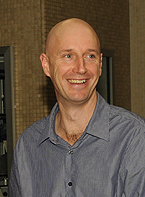Beyond Darcy: Improving Estimates of Groundwater Flow Rates
May 29, 2009

In parts of Australia and the western U.S., groundwater is being pumped from the ground for agricultural use faster than it can be naturally replenished. This leads to a falling water table, which means wells have to be deepened and more energy is needed to pump water. It also leads to compaction of the soil, which cracks roads, pipelines and building foundations, or massive slumps that swallow neighborhoods. That’s not to mention the ecological impacts to fish and amphibians from the reduction of aquifer habitats.
Peter Cook is a senior principal research scientist with CSIRO Land and Water, a division of Australia’s national science agency, Commonwealth Scientific and Industrial Research Organisation. Cook’s research is aimed at groundwater sustainability.
“As water becomes more and more valuable, we need to make more accurate predictions about the future,” he said.
To make groundwater use sustainable, the goal is to strike a balance between the rate of water going into the aquifer (recharge) and the rate of water being removed for human use (withdrawal). To find that balance, you have to know what the recharge rate is. And to accurately measure recharge, you have to know how quickly water moves through the ground, also known as the groundwater flow rate. Measuring that accurately, said Cook, can be harder than some hydrogeologists would care to admit.
The standard hydraulic technique involves drilling wells, measuring certain features of subsurface sediments, rocks and water, and estimating the location and slope of the water table (the top of the aquifer). This information is applied to a mathematical relationship discovered by French engineer Henry Darcy in the 19th century, now known as Darcy’s Law, to determine the groundwater flow rate. That technique works fairly well for simple groundwater systems where hydraulic conductivity—the ease with which water moves through sediments and rocks—varies little from place to place. But many systems are highly heterogeneous.
“You could measure hydraulic conductivity in one spot, move over five feet and measure it again and get wildly different answers,” said Cook. “There’s no way you could drill enough wells.”
Cook presented his prescription in a lecture at the Jackson School titled “Environmental Tracers in Modern Hydrogeology: Reducing Uncertainty in Ground Water Flow Estimation,” during an international tour as the 2009 Henry Darcy Distinguished Lecturer sponsored by the National Groundwater Association. The lectureship is named in honor of the same Darcy who discovered the law.
How Old is This Water?
Environmental tracers are chemicals that are widespread in the environment that put a time stamp on water, indicating when it last had contact with the air. These tracers include substances that mark specific events such as tritium—a radioactive form of hydrogen created by nuclear bomb tests in the 1960s and quickly scattered across Earth’s surface—and chlorofluorocarbons, or CFCs, which were widely used as refrigerants for decades and were then banned in the 1990s. They also include naturally occurring radioactive elements such as carbon-14 which decay in a predicable way. By plotting the age of water at certain spots, it’s possible to estimate groundwater flow rates.
Tracers also have the useful property that they integrate information about water over a large area. So in a sense, they average out variations in hydraulic conductivity from place to place. In highly heterogeneous systems, this results in more accurate estimates of groundwater flow rates.
Another type of system where tracers could help are those where the rocks are highly fractured. This creates short cuts in the system so that old water and young water have a chance to mix, making flow paths very complicated. Used alone, tracers and the standard hydraulic technique each have an extremely difficult time characterizing such systems. But together, said Cook, the two techniques can be combined to reduce uncertainties, especially when multiple tracers are used.
“These are some of the most complicated systems we work in,” he said.
Despite improvements in recent years, Cook said environmental tracers are not used widely outside of academic research. He said part of the problem is that hydrogeologists either aren’t aware of, or would prefer to downplay, the uncertainties in their traditional hydraulic-based estimates.
“Unless you do uncertainty analysis,” he said, “there won’t be an incentive to look for newer or better ways.”
And what of Monsieur Darcy—famed for revolutionizing 19th century France’s public water system and laying the intellectual groundwork for the field of hydraulics? It’s hard to imagine that he would mind having his name associated with a lecture advocating that scientists move beyond his famous formula to gain an even richer view of the watery world beneath our feet.
For more information about research at the Jackson School, contact J.B. Bird at jbird@jsg.utexas.edu, 512-232-9623.
